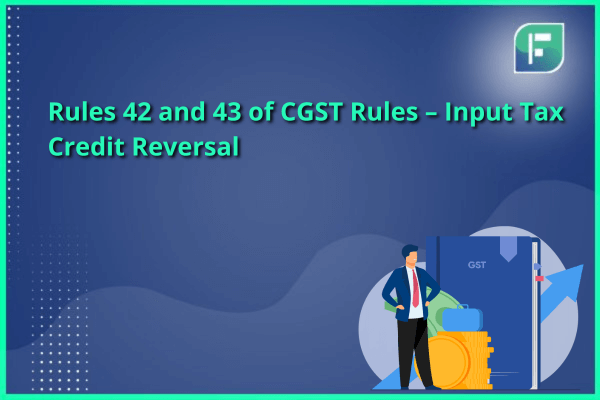Rules 42 and 43 of CGST rules govern the allowance of input tax credit claims. These rules specifically apply when the supplied goods or services are used both for business and non-business purposes. It is essential for taxpayers to adhere to these rules to ensure the proper claiming of input tax credits. In this blog, we shall learn about the Rules 42 and 43 of CGST rules for ITC reversal.
Input Tax Credit Claims under Rules 42 and 43 of CGST rules
In instances where the supply is utilised partially for business and partially for other purposes, taxpayers must follow the guidelines outlined in Rules 42 and 43 of CGST rules. These rules dictate that if the input tax credit claim results in a nil amount, the taxpayer is obligated to reverse the claim.
Compliance with CGST Regulations for Input Tax Credit
Claiming input tax credit under the circumstances described above requires strict adherence to Rules 42 and 43 of CGST rules. Taxpayers are required to carefully evaluate and segregate the usage of the supplied goods or services for business and non-business purposes. Failure to comply with these rules may result in complications when attempting to claim input tax credits.
Rule 42 of CGST Rules: Allocation of Input Tax Credit
When exploring Rules 42 and 43 of CGST rules, Rule 42 of the CGST Rules pertains to the allocation of input tax credit for goods or services that are partly for business purposes as well as partly for other purposes, or for making taxable and exempt supplies. The allocation is determined based on specific criteria outlined in the rule.
1. Criteria for Allocation (Rule 42, Subsection 1 and 2 of Section 17):
- The input tax credit for input services or inputs falling under subsection (1) or subsection (2) of section 17, partly used for business and partly for some other purposes or for making taxable and exempt supplies, shall be allocated.
2. Allocation Methods (Rule 42, Subsection 1):
The allocation is based on:
- Total input tax on goods and services during a tax period designated as “T.”
- Input tax attributable to goods and services used exclusively for purposes other than business (designated as “T1”).
- Input tax attributable to goods and services used exclusively for effecting exempt supplies (designated as “T2”).
- Input tax attributable to goods and services used for effecting supplies other than exempted, including zero-rated supplies (designated as “T4”).
3. Declaration in FORM GSTR-2 (Rule 42, Subsection 1, Clause g):
- The registered person declares “T1,” “T2,” “T3,” and “T4” at invoice level in FORM GSTR-2.
4. Calculation of Standard Credit (Rule 42, Subsection 1, Clause h):
- The input tax credit remaining after allocating under clause (g) is termed the standard credit (“C2”) and calculated as C2 = C1 – T4.
5. Calculation of Exempt Supplies Credit (Rule 42, Subsection 1, Clause i):
- The input tax credit attributable to exempt supplies is designated as “D1” and calculated as D1 = (EF) C2, where “E” represents the total value of exempt supplies, and “F” is the registered person’s overall turnover in the State during the tax period.
Rule 43 of CGST Rules: Input Tax Credit for Capital Goods
Among Rules 42 and 43 of CGST rules, Rule 43 of the Central Goods and Services Tax rules outlines the procedures for calculating and, in certain circumstances, reversing input tax credits for capital items. Understanding the input tax credit allocation for capital goods is crucial for compliance.
1. Criteria for Allocation (Rule 43, Subsections 1 and 2 of Section 17):
- Input tax credit for capital goods subject to subsections (1) and (2) of section 17, partly used for business and partly for some other purposes or used for both taxable and exempt supplies, shall be attributed.
2. Allocation Methods (Rule 43, Subsection 1):
Allocation is based on:
- Amount of ITC related to capital goods used exclusively for non-business activities or exempt supplies (designated as “A”).
- Amount of ITC related to capital goods used for supplies other than exempt supplies, including zero-rated supplies (designated as “Tc”).
3. Declaration in FORM GSTR-2 (Rule 43, Subsection 1, Clauses a and b):
- The amount of ITC related to capital goods under clauses (a) and (b) shall be indicated in FORM GSTR-2.
- The input tax related to capital goods under clause (a) shall not be credited to the computerised credit ledger.
- The input tax related to capital goods under clause (b) shall be credited immediately to the computerised credit ledger.
4. Validity of Useful Life (Rule 43, Subsection 1, Clause c):
- The useful life of such capital goods continues up to five years from the date of the invoice.
- Amount “A” not covered under clauses (a) and (b) shall be credited to the electronic credit ledger. The value of “A” decreases at a rate of 5 percentage points for every quarter or portion thereof.
5. Calculation of Standard Credit (Rule 43, Subsection 1, Clause d):
- The standard credit for capital goods for a tax period is the total of what are the sums of “A” credited to electronic credit ledger under subsection (c), marked as “Tc.”
Final Thoughts
Rules 42 and 43 of CGST Rules govern the allocation and reversal of input tax credits, ensuring a systematic approach in cases where goods or services are used for both business and non-business purposes. Rule 42 delineates the allocation of input tax credits for general supplies, specifying methods and criteria for attribution. On the other hand, Rule 43 addresses the specific scenario of capital goods, providing guidelines for the allocation and crediting of input tax related to these items. Both rules underscore the importance of compliance, accurate documentation in FORM GSTR-2, and adherence to prescribed procedures to facilitate seamless and transparent processes in input tax credit within the GST framework.






